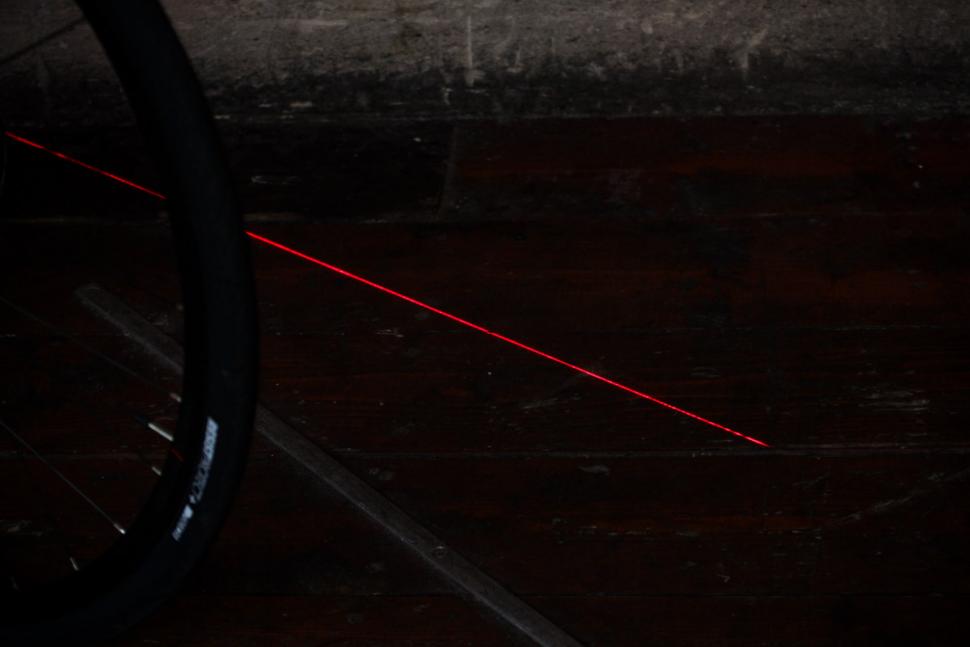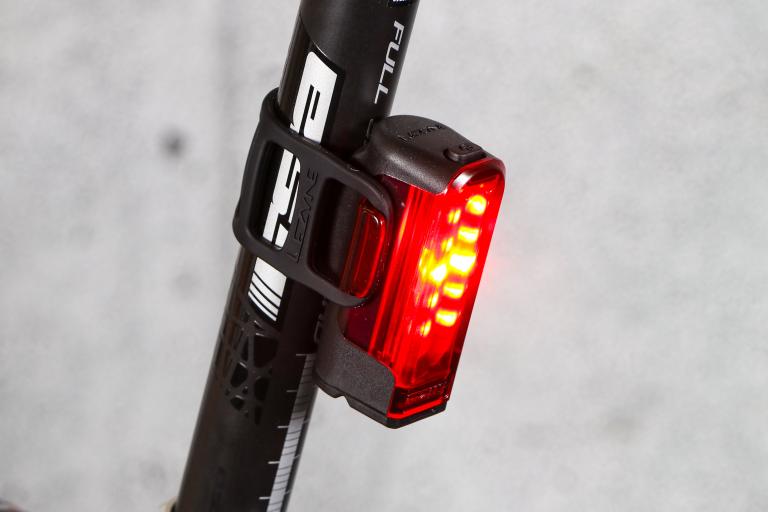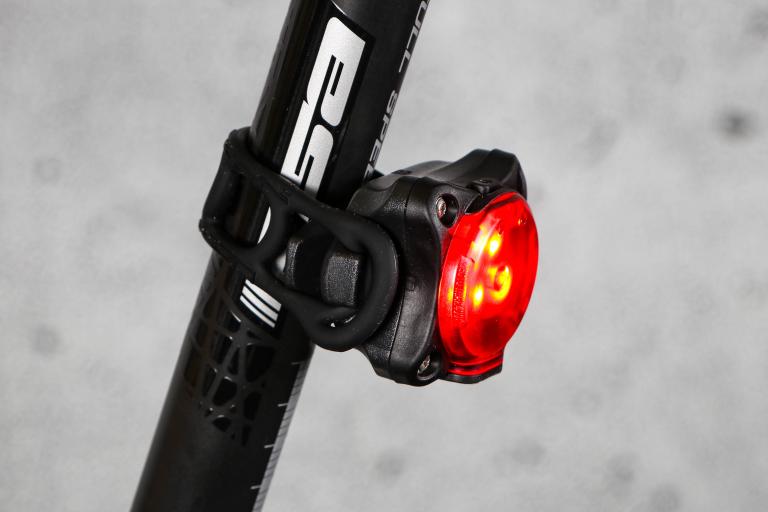- News
- Reviews
- Bikes
- Accessories
- Accessories - misc
- Computer mounts
- Bags
- Bar ends
- Bike bags & cases
- Bottle cages
- Bottles
- Cameras
- Car racks
- Child seats
- Computers
- Glasses
- GPS units
- Helmets
- Lights - front
- Lights - rear
- Lights - sets
- Locks
- Mirrors
- Mudguards
- Racks
- Pumps & CO2 inflators
- Puncture kits
- Reflectives
- Smart watches
- Stands and racks
- Trailers
- Clothing
- Components
- Bar tape & grips
- Bottom brackets
- Brake & gear cables
- Brake & STI levers
- Brake pads & spares
- Brakes
- Cassettes & freewheels
- Chains
- Chainsets & chainrings
- Derailleurs - front
- Derailleurs - rear
- Forks
- Gear levers & shifters
- Groupsets
- Handlebars & extensions
- Headsets
- Hubs
- Inner tubes
- Pedals
- Quick releases & skewers
- Saddles
- Seatposts
- Stems
- Wheels
- Tyres
- Health, fitness and nutrition
- Tools and workshop
- Miscellaneous
- Buyers Guides
- Features
- Forum
- Recommends
- Podcast
review
£55.00
VERDICT:
A smart light, but expensive and there's little sign that the lasers offer any real safety benefit
Weight:
74g
Contact:
At road.cc every product is thoroughly tested for as long as it takes to get a proper insight into how well it works. Our reviewers are experienced cyclists that we trust to be objective. While we strive to ensure that opinions expressed are backed up by facts, reviews are by their nature an informed opinion, not a definitive verdict. We don't intentionally try to break anything (except locks) but we do try to look for weak points in any design. The overall score is not just an average of the other scores: it reflects both a product's function and value – with value determined by how a product compares with items of similar spec, quality, and price.
What the road.cc scores meanGood scores are more common than bad, because fortunately good products are more common than bad.
- Exceptional
- Excellent
- Very Good
- Good
- Quite good
- Average
- Not so good
- Poor
- Bad
- Appalling
The NiteRider Sentinel 250 is a brighter version of the regular Sentinel light tested previously on road.cc. It packs the same lasers, creating a unique virtual cycle lane, but ups the brightness to a whopping 250 lumens. It's easy to use, provides several modes and the battery life is good, but I'm not convinced that the lasers bring much benefit.
- Pros: VERY BRIGHT, lasers, battery run-time
- Cons: Lasers, bracket, buttons
The unique appeal of the Sentinel, and really the main reason you'd buy it over any other light, is the pair of lasers which create a virtual cycle line behind your bike. There are three modes of lasers, and you can choose to activate them on their own or in conjunction with the two main LEDs.
> Find your nearest dealer here
Ride or drive behind a cyclist with the Sentinel and you'll see two long lanes projected onto the road behind and alongside the rear wheel. The width and length of the lanes are dictated by how you mount the light to the bike. The idea behind the lasers is to suggest to other road users that they pass at a safe distance. In my experience, riding in both rural and urban environments, I didn't feel any safer than with a regular rear light. Close passes still occurred despite the lasers flashing a path behind me.
What certainly seems to get motorists' attention is the whopping 250-lumen output. That is seriously bright for a rear light. Skip straight down to the comments section if you want to join in a debate about how bright is too bright.
You can choose from two flash and two steady modes, the latter providing high and a useful group ride mode that ensures you don't blind your mates. There's also a daylight visible flash mode, as is increasingly common with rear lights for those cyclists interested in running lights during the day as well as at night.
> Buyer's Guide: The best front lights for cycling + beam comparison
The Sentinel is well made and is IP64 dust and water-resistant. It has stood up to a couple of rides in the rain, getting subjected to lots of mud, and my very unscientific hosepipe test.
The two rubber buttons are fiddly to use with big gloves; perhaps separating them would provide easier use?
Battery life is good and on the money, with a minimum 5hrs if using the main light on a flash mode without a laser, up to 45hrs on a steady beam and 11:30hrs for the lasers. There's a low battery indicator when you turn the light off – the centre circle lights up red if the battery is low. The light is easily recharged via a USB cable, taking just 3hrs.
> Buyer's Guide: 16 of the best rear lights for cycling
The bracket comprises a silicone band that is familiar and easy to use, and went onto a few different bikes including an aero seatpost with no problems. What is a problem is how flimsy the main bracket is; the light moves up and down too easily, and on my first outing the weight of the light caused it to pivot down and project the lasers onto my legs! You have to tighten the crosshead screw a lot to get it to stay firmly in place. On the plus side, it never came loose but I'd prefer a better designed bracket at this (or any) price.
It's a smart and clever design but I'm not convinced the lasers provide any actual road safety benefit, which leaves just an extremely bright light with good battery life but a flimsy bracket. Add in the £55 RRP (cheaper if you shop around) and it's pricey too. If you don't need 250 lumens, there are some excellent cheaper options, such as the Exposure TraceR Daybright and the Blackburn DayBlazer 65 Rear, to name but two.
Verdict
A smart light, but expensive and there's little sign that the lasers offer any real safety benefit
road.cc test report
Make and model: NiteRider Sentinel 250
Size tested: 250 Lumens
Tell us what the light is for, and who it's aimed at. What do the manufacturers say about it? How does that compare to your own feelings about it?
NiteRider says, "The NiteRider® Sentinel™ 250 is designed to increase cycling safety by way of 2 varying flash patterns and 2 steady beams (High/Group Ride Mode). Behind the durable red lens and casing are two powerful LEDs that emit 250 lumens in the brightest Daylight Visible Flash setting, allowing you to be seen day or night. For enhanced safety, the Laser Lane modes (3) are designed to project ultra-bright laser lines on the ground. This creates a virtual lane for the rider, further increasing visibility."
Tell us some more about the technical aspects of the light?
NiteRider lists:
* Daylight Visible Flash (DVF)
* A wearable safety light – clip onto various straps, belt loops, etc.
* Highly visible laser lanes
* All in one, Laser and tail light!
* Convenient USB rechargeable
* Group Ride Mode – be seen without distracting fellow cyclists
* Easy on and off seat post strap mount with quick release tab
* FL1 Standard IP64, dust and water-resistant
Rate the light for quality of construction:
6/10
Rate the light for design and ease of use. How simple was the light to use?
6/10
Rate the light for the design and usability of the clamping system/s
6/10
Rate the light for waterproofing. How did it stand up to the elements?
7/10
Rate the light for battery life. How long did it last? How long did it take to recharge?
7/10
Rate the light for performance:
7/10
Rate the light for durability:
7/10
Rate the light for weight:
6/10
Rate the light for value:
5/10
It's pricey compared to other lights; though you do get lasers.
Tell us how the light performed overall when used for its designed purpose
Works as intended.
Tell us what you particularly liked about the light
The lasers give it a real USP.
Tell us what you particularly disliked about the light
Bracket and fiddly buttons.
How does the price compare to that of similar products in the market, including ones recently tested on road.cc?
There are cheaper lights with a smarter overall design and neater brackets if you don't need the lasers (or the lumenage).
Did you enjoy using the light? No
Would you consider buying the light? No
Would you recommend the light to a friend? No
Use this box to explain your overall score
Unless you really want the lasers, it's an expensive light, the bracket isn't great and it's a bit chunky.
About the tester
Age: 31
I usually ride: My best bike is:
I've been riding for: 10-20 years I ride: Every day I would class myself as: Expert
I regularly do the following types of riding: road racing, time trialling, cyclo-cross, commuting, touring, mountain biking
David worked on the road.cc tech team from 2012-2020. Previously he was editor of Bikemagic.com and before that staff writer at RCUK. He's a seasoned cyclist of all disciplines, from road to mountain biking, touring to cyclo-cross, he only wishes he had time to ride them all. He's mildly competitive, though he'll never admit it, and is a frequent road racer but is too lazy to do really well. He currently resides in the Cotswolds, and you can now find him over on his own YouTube channel David Arthur - Just Ride Bikes.







Not many animals cause grinding noises when underneath a vehicle.
I listened to the BBC R4 prog "Should cyclists stay in their lane" and it was pretty much what you'd expect from the BBC, a well-informed cyclist...
Of course you don't actually want to spend money intended for infrastructure on infrastructure, you want to spend it on plans for infrastructure,...
My bet is that all these tires popping off are from people with bad pressure gauges or they're simply just putting too much air in on purpose. ...
You have to add images via a reply to yourself after the topic is created. One at a time too.
“Plus, riders who pair CarBack to their smartphone using the Trek Accessory app can enjoy even more features, including the ability to see the...
Had a Kona Blast sometime around the turn of the century, that was a pretty decent mountain bike for not much money....
David9694 - you were right! These new autonomous vehicles really are conspiring to run out of control!...
Decathlon have the Garmin Varia RTL515 on offer at the moment for £129.99: https://www.decathlon.co.uk/p/rearview-radar-varia-rtl515-65-lumens/_/R-...
So when you said "all Jews" you didn't actually mean all Jews, just religious ones. However even that distinction is erroneous, as you must surely...